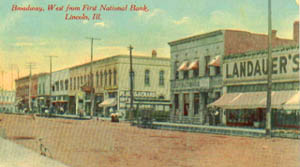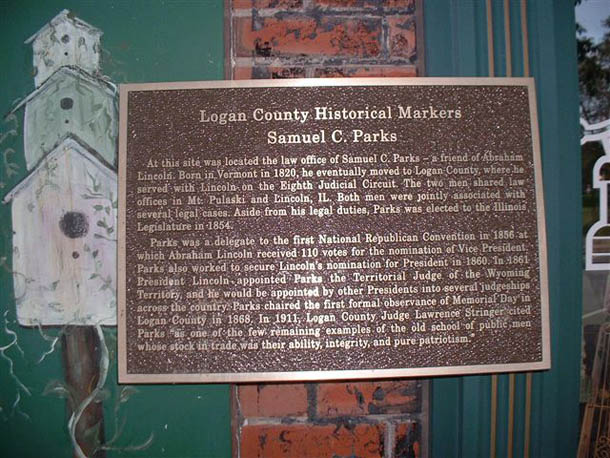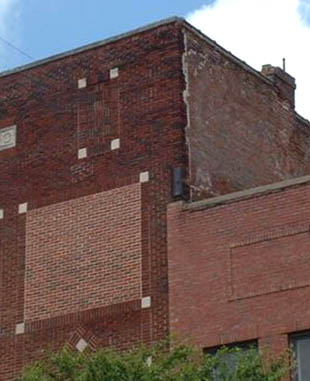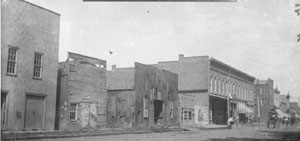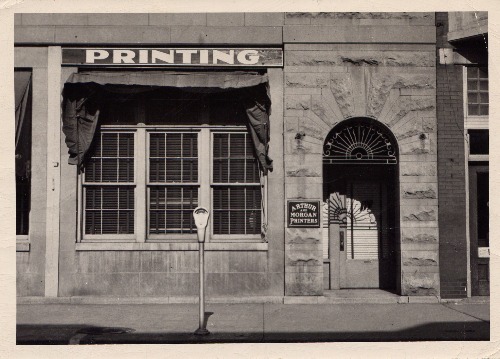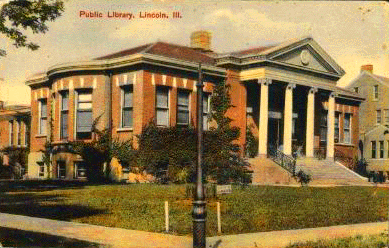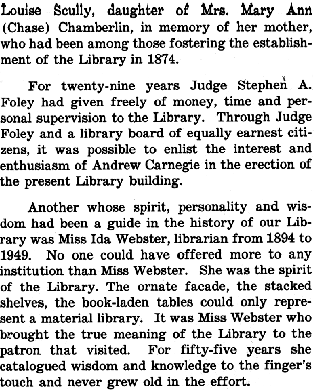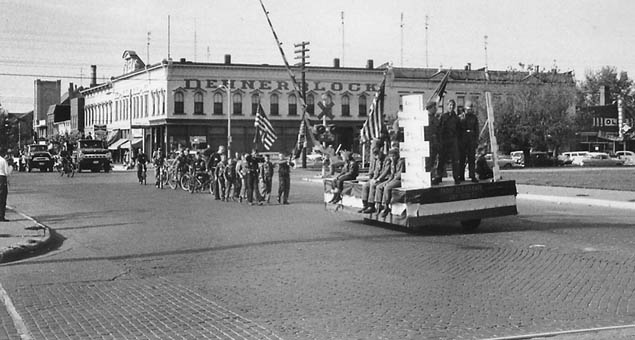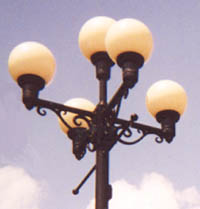|
Internet Explorer is the only browser that shows this page the way it was designed.
Your computer's settings may alter the display.
April 24, 2004: Awarded "Best Web Site of the Year" by the Illinois State Historical
Society
|
|
|
|
Marquee Lights of the Lincoln Theater, est. 1923, Lincoln, Illinois |
|
|
|
15. Vintage Scenes of the Business & |
|
|
|
|
| Street Scenes | |
|
15.1: Picture
Postcard of Courthouse Square, Looking North on Kickapoo Street, 1914 |
15.2: Picture Postcard of Courthouse Square Looking West on
Broadway, 1910 |
|
In 15.1, on
the curbs are five-globed streetlights. In the center of the street
are streetcar tracks, and in the background are the mature Elm trees of
Latham Park. The Gillett Building appears at the end of the block seen
at the left of 15.1, and the other building of the same design as the
Gillett Building is the Latham Building (middle of the block), as described
later on this page. |
|
|
|
15.4: Picture Postcard Showing
|
|
The three-story Gillett Building seen as the
large building at the right of 15.3 was replaced with a
two-story building, which housed Kresge's, then Thornton's (15.4). This new building is known as the Griesheim Building, and I have information
about it later on this page. The vertical sign in
front of the tall red building in 15.4 says "Myers Bros." (clothing store). |
|
|
Buildings The Gillett Building The largest and perhaps the most significant building in the history of the Logan County Courthouse Square was the Gillett Building, also known as the Oglesby Building. "In 1867 John D. Gillett began the erection of the Gillett Block on the corner of Broadway and Kickapoo Streets. Prior to this date this corner had been occupied by corn cribs and in the winter of 1865, Palmer's circus wintered there. . . . . The block [Gillett Building] [was] three stories in height, built of brick and has a frontage of 80 feet. The first floor originally contained five store rooms, the second floor contained office rooms and the Masons occupied the third story. The contractor was T.F. Ladue and the building was completed in August of 1868" (Stringer, p. 576). The second story also housed a facility known as Gillett's Hall. "In connection with the erection of Gillett's Hall, it may be noted that among the first entertainments given in the hall in 1868 was a lecture by a man whose name is now internationally immortal, Ralph Waldo Emerson. In a four line notice of his lecture, a local paper referred to the address as 'quite interesting'" (Stringer, p. 577). Note: I have done a little research into Emerson's lectures given in Illinois and have not been able to substantiate the claim the Emerson spoke in Lincoln, Illinois. One of the most significant events held in Gillett's Hall was the "Cartwright Jubilee," September 24, 1869, to honor Peter Cartwright on the 65th anniversary of the beginning of his career as a Methodist evangelist. On that occasion Cartwright spoke "in his peculiar manner which gave him such a name for eccentricity." Among the gifts he received "were a silver set of 33 pieces presented by the citizens of Decatur, a Turkish chair presented by Gov. R.J. Oglesby, a gold-headed cane, gold spectacles, gold and silver ware, and a photograph album containing photographs of the ministers of the conference, etc. Three years after the Jubilee, Peter Cartwright passed away, being over 80 years of age." (Stringer, 1911 History of Logan County, Illinois, p. 494). Another significant part of local history that took place in Gillett's Hall was the sensational, 1904 trial regarding the dispute over the will of John P. Gillett, son of John D. Gillett, that pitted one side of his family against another over the Gillett family fortune. In his Ancestors: A Family History (1971, pp. 160--161), William Maxwell outlined the drama of the epic legal proceedings because the trial was part of his family's history: his paternal Grandfather William C. Maxwell was a lawyer for one side of the Gillett family, and his maternal Grandfather Edward D. Blinn was a lawyer for the other side: John D. Gillett's "death gave rise to a Balzacian novel. Part I has to do with his will. in devising [dividing?] his land to his children he gave his only son, John Parke Gillett, a double portion and so set the plot of the novel in motion. He also left his widow a lifetime interest in 3,800 acres of land and personal property worth $100,000. In Part II she died, and her children could not come to an agreement as to how her share of the estate could be divided, so it was owned by the heirs in common. In Part III one of the sisters died and willed her share to her brother. With what was eventually going to come to him from his mother, he ended up owning seven-sixteenths of the original estate. In Part IV he made a will in which he left the bulk of his property to Miss Jessie Gillett, my Grandfather Maxwell's client. In Part V he added a codicil in which the same property was left to Mrs. Oglesby and a nephew. In Part VI he died and the sisters, waiting to be informed of the time and place of the reading of the will, were informed, instead, that the will could not be found . . . ." "The will, or a will, of John Parke Gillett must have turned up, because in Part II certain of the sisters tried to have in set aside on the ground that their brother was insane. In Part VIII the plot becomes dizzying. Two of the sisters would combine forces against the others, and then they would have a falling out, and there would be new combinations. What was being fought over was, at a rough estimate of its present-day value, five or six million dollars." "I still don't know anything like the full details of this immensely complicated story; the broad outlines I got partly from a newspaper clipping in my grandmother's scrapbook and partly from a Lincoln lawyer, a man of my father's generation. He was a schoolboy when all of this happened and was present at the trial." [Note: this lawyer was probably John Dean Gillett Hill, who was one of William Maxwell's father's best friends and the son of Katherine Gillett Hill, one of the Gillett sisters involved in the trial.] Maxwell's account continues: "'Practically every lawyer in the county was involved in the case," he [Mr. Hill?] wrote me, when I asked him about it. "Your Grandfather Blinn was one of the battery of lawyers representing Mrs. Oglesby, and apparently by questionable means he had got hold of some highly useful letters. He would get one of the girls on the witness stand and would ask her a question about certain happenings. After she had answered, he would say with great delight, 'I will see if I can refresh your recollection,' and then he would produce a letter she had written which contradicted her testimony in some one or more details. It was a great show, and it lasted all summer. The jury found that John P. Gillett was of sound mind when he made his will, but it was not the easiest thing in the world to determine because he was drunk most of the time." Maxwell describes the effect of the trial outcome on his family: "My Grandfather Blinn won the case, who didn't need to win it. My Grandfather Maxwell, as I have said, was on the opposite side. My father used to say that it was the first case my Grandfather Maxwell ever had where the fee was substantial, that the part he took in the trial considerably enhanced his reputation, and that itf he had continued to be Miss Jessie Gillett's legal advisor he would no longer have worried about the bill from Boy's Dry Goods Store." [Note: At this store lawyer Maxwell's wife ran a bill that upset him because he considered it far too high.] Maxwell concludes: "Instead, his [Grandfather Maxwell] health broke down. Other lawyers attended to Miss Gillett's legal affairs, and my grandfather spent the remaining year or two of his life in and out of bed." Taking advantage of the internet as a research tool, I discovered more details about the 1904 Great Gillett Family Real Estate Trial that confirm and expand Maxwell's account. Indeed, at issue was the validity of a codicil of John P. Gillett's will. John P. inherited the bulk of the estate of his father, John D. Gillett, who was known as the "Cattle King of the World." "The codicil bequeathed the property [mostly real estate valued at $500,000] to Mrs. Emma Gillett Oglesby, her sister Nina L. Gillett, and Hiram G. Keays, son of Mrs. Oglesby by her first marriage, instead of Miss Jessie D. Gillett, who was a sister of Mrs. Oglesby. The original will had bequeathed the property to Jessie D. Gillett. Aligned with Jessie D. Gillett were her other sisters: Mrs. Katherine Gillett-Hill of Lincoln, Mrs. Charlotte M Barnes of Decatur, and Ms. Amaryllis T. Gillett of Chicago. The contestants of the will based their case upon the charge that John P. Gillett was of unsound mind at the time he wrote the codicil" (The Decatur Daily Review, July 28, 1904, p. 1). The reason for the charge that Mr. Oglesby was allegedly of unsound mind was his well-known alcoholism. The trial lasted six weeks, featuring approximately 200 witnesses, involving eight "high salaried" attorneys, and costing $70,000. The trial brought about various plot-twisted revelations and developments, and produced voluminous newspaper reports. Many citizens believed the trial would result in a hung jury, but the jury decided that John P. Gillett was not insane and that the codicil was valid.
The Gillett-Oglesby Building burned on February 23, 1932, at a loss of
$100,000, plus other buildings worth an additional $80,900 (Gleason,
Lincoln: A Pictorial History, p. 180). This Gillett Building
is the three-story structure depicted in 15.5 below. |
|
15.5: The Gillett Building at Broadway and Kickapoo Streets in 1919 (Photo in Gleason, Lincoln: A Pictorial History, p. 100) Paul Gleason notes
that this photo looks west on Broadway during the WW I homecoming parade. Part of the Lincoln House appears just to the right of the center flag on
the wire. The Civil War statue can been at the left. The steeple
of the 1868 Methodist Church at Broadway and Logan Streets is visible in the
right background corner. On the Gillett Building, the name Altman is
visible. A closer look also reveals Boyd and Paisley, the name of a
major dry goods store in the late 19th, early 20th Centuries. A.C. Boyd is the store in which, according to William Maxwell, his
Grandfather Maxwell thought Mrs. Maxwell spent way too much, and that
concern led to domestic unpleasantness (Ancestors,
pp. 144-145). Access
the following link for the story of the 1932 fire that destroyed the
Gillett-Oglesby Building: The Griesheim Building Replaces the Gillett-Oglesby Building The following information comes from Bill Livingston of Newport Beach, CA, in email correspondence with Leigh Henson in January, 2004, and is presented here with Bill's permission:
"The 'first' Griesheim Building was purchased from the
Gillett-Oglesby heirs by Meyer Griesheim. At one time is was apparently
known as "The Kresge Corner." A men's clothing store was operated on the
premises until a fire destroyed the 64-year-old structure in 1932. Two
people also tragically died in that fire . . .occupants seemingly trapped in a
third floor apartment. We have been
in the process of major renovation and modernization of the building during
the last year and hopefully the building will provide the citizens of
Lincoln with a beautiful place to live and work for many years to come.
Access the following link for information about the Griesheim Building
that replaced the Oglesby-Gillett Building:
http://findinglincolnillinois.com/stanstringer.html#griesheim.
|
|
The Latham Building: An Example of Lincoln's "Usable Past" The Latham Building is pictured below in approximately 1880 with its first major occupant, the Lutz dry goods store, in the center of the Kickapoo Street block of the Logan County Courthouse square. Col. Robert B. Latham, one of the three founders of Lincoln, Illinois, and extensive property owners there, constructed this building after he returned from the Civil War. The building just beyond it with the same design is the Gillett Building, later known as the Oglesby Building. The Gillett Building was constructed by John Dean Gillett, another founding father and owner of the first Lincoln namesake town. The Gillett Building was constructed in 1867, the Latham Building in 1868 (Stringer, pp. 577-8). As shown later on this page, the Latham Building is still standing and occupied in 2007. For more information about Robert B. Latham and John D. Gillett, see Mr. Lincoln's Role in the Founding of Lincoln, Illinois, and the Watermelon Christening Monument in this Web site.
15.6: One of the Earliest Photos
of the Latham Building (Lutz), (photo from Gleason, Lincoln: A Pictorial History, p. 75)
The Latham Building narrowly escaped a ruinous fire in 1873.
Stringer writes "Prior to
1870 the court house had furnished the only fire of importance [1857],
but from April 7, 1870, to April 1, 1878, ten different fires occurred
in the business district. . . . A very disastrous fire occurred on
the night of March, 1873. It originated in the second story of a
building occupied by Hart & Eves as a bakery and the fire consumed all
the buildings on the north side of Pulaski Street from the alley to
Kickapoo Street and then around on Kickapoo Street to Latham's block,
opposite the Kickapoo Street entrance to the court house. The loss was
estimated at $30,000, 16 firms being burned out" (pp. 577-78). One
source Stringer used for the scarcity of serious fires in downtown
Lincoln prior to 1870 is the 1886--87 history of Logan Co. Let me
emphasize that Stringer says the fire went "to Latham's
block," so the fire was stopped or died
down before destroying the Latham Building. ["Block" refers to a
series of lots but does not necessarily mean a series of lots spanning
from one street to another. Robert Latham may have built on four
contiguous lots in this block--some of the choicest property in town
because it directly faced the then-front of the Logan County Courthouse.] |
|
|
15.7: Late
19th, Early-20th-Century View of Latham and |
|
|
15.8: Picture
Postcard View of Latham Building from
15.9: Black and White
Picture Postcard View of Latham Building from Early 1960s |
|
|
15.10: Latham Building in the 1960s--1970s (photo courtesy of D.D. Welch and Fred Blanford) Whoever took and processed the above photo cut off the very top of the building, including the nameplate, seen below. The occupant of the ground floor of the Latham Building during the 1960s-1970s was Myers Brothers, a clothing store whose main location was in Springfield, Illinois. At some point early in the 20th century, the Lincoln Elks Club bought the Latham Building. Prior to that, various business professionals rented offices on the upper floors, including insurance men, doctors, and lawyers. The Elks had previously rented space in the Lincoln House, but that building was very old, and the Elks wanted their own building. The Elks Town Club was located on the second and third floors for many years in mid 20th century. The third floor was used as a dance hall. See my friend and true Lincolnite at heart Bill Gossett's recollections of the Elks Club in Lincoln, including a description of the interior of the Elks Town Club in the Latham Building. That page also has more information about the Elks in Lincoln, including the Elks Country Club.
15.11: Nameplate (1910 new front wall) (photo courtesy of Pat Hartman, Leigh Henson's wife) |
|
|
15.12: Latham Building Housing the Cherished Memories Antique Mall in 2007 (photo courtesy of Nancy Saul) |
|
|
15.13: Samuel C. Parks Plaque on Right Front of Latham Building (photo courtesy of Pat and Gary Freese) The location of the law office of Samuel C. Parks had long been a question for local historians. Recently, information was discovered that places his office at the site of the Latham Building but in a preceding structure, for which no other information or photo has been found. As a result this discovered location, the plaque above has been installed. The story of discovering the location of the Parks law office is told by Nancy Rollings Saul in the following article appearing in the Lincoln Courier on February 10, 2004: Historians for years have been searching for the location of a law office on the west side of Lincoln's downtown square that Abraham Lincoln shared with prominent local attorney Samuel Parks. Now they know, thanks to Alice Thornton of rural Lincoln. She inadvertently solved the mystery last summer when she brought to The Courier several pages from a scrapbook compiled by her late sister, Sarah Brown. Before Brown's death, Thornton donated the pages on her behalf. Since the clippings were of a historical nature, the women hoped they would be useful to someone, especially during Lincoln's sesquicentennial year. The scrapbook pages Brown compiled about the 16th president were donated to the Lincoln College Museum. Those with pictures of many Logan County men who fought in World War II were given to the Logan County Historical and Genealogical research center. A story about Abraham Lincoln, clipped from the Feb. 12, 1942, Lincoln Evening Herald, mentioned that Lincoln shared a law office with attorney Samuel Parks from about 1857, to about 1860, on the second floor of the building at 117 1/2 S. Kickapoo St. . . . Historians were seeking the exact location of the law office, so Main Street Lincoln can erect a plaque near the site, detailing Parks' illustrious career. Local historian Paul Gleason said the antique mall is not the original law office building. . . . [Leigh's note: The present Latham Building could not possibly have been the building in which Parks had an office when he partnered with Lincoln. That relationship occurred before the Civil War, but the Latham Building was constructed after the War--in 1868.] Besides working with Lincoln when Lincoln rode the old 8th Judicial Circuit, Parks was a delegate to both the 1856 Republican convention in Philadelphia and the 1860 Republican convention in Chicago. "Being from northeast, he was able to convince his friends to support Lincoln," Gleason said. During his life, Parks served as a teacher, school board commissioner, lawyer, judge, legislator, landowner and college board trustee. He lived in Logan County during the area's formative years and, on the night Lincoln was nominated for the presidency, Parks was one of several speakers at a celebration held at the Logan County Courthouse.
For more information about Samuel C. Parks, see
his profile in
this Web site. |
|
|
15.14: Latham Building Front and South Walls (photo
courtesy Pat and Gary Freese) |
15.15: Latham Building Front and North Walls (photo
courtesy Pat and Gary Freese) |
|
The
documentation for the Logan County Square Historic District (National
Register of Historic Places Inventory) gives 1910 as the approximate
date for the construction of the Latham Building. However, 1910 is
apparently the date for construction only of a new front wall (face) for
the 1868 structure, which remains as the predominant construction of the
present-day Latham Building. The color and texture of the bricks in the
photos above suggest that the side walls are older than the
front wall, and these photos show what appears to be a dovetailing of
the 1910 face with the older sidewalls. Pat Freese says the interior of
the lower level of the building has brick walls that appear to be
original to the 1868 construction and seem to be load-bearing supports. You will also notice that the chimney that protrudes from the south
wall of the contemporary building (left photo above) is clearly evident
in the 1880 photo of the building farther up on this page. The existing windows in the front wall most likely are original to the
1910 construction. The basement area extends beneath Kickapoo Street. |
|
| Two Men Whose Buildings on the Square Were Next to the Lot Once Owned by Abraham Lincoln | |
|
Quite a lot is known about Dr. Donald because of his biographical sketch in Stringer's 1911 History of Logan County and a 1953 article in the Lincoln Evening Courier. Most significantly of all, Dr. Donald appears in several of William Maxwell's works. In Maxwell's Time Will Darken It, Dr. Donald was the model for Austin King's kind and wise neighbor, the deaf Dr. Danforth, a horse veterinarian. |
15.16: Looking
West on Pulaski Street in
the 1880s on the South Side the Courthouse Square The photo immediately below, shows a later building that Dr. Donald built to replace the ones above in the center. The Lincoln Horse and Mule Market was located where the Arcade Building was later built. |
|
In the mid-20th Century, in a building near the center of this block, just to the left of the present Arcade Building, another doctor maintained an office. He was Dr. Jeffrey Fults, optometrist, whose oldest son, Jeff, made history when he drove the black Cadillac a photo toward the bottom of this page. Dr. Danforth astutely advises Austin King on a personal and legal problem. Austin's foster cousin, Rueben Potter, visiting from Mississippi, had solicited some of Austin's friends to invest some money in a vague business deal. Austin does not invest, but agrees to draw up the papers. The business venture proves to be a bust, and Austin's "friends" want to hold him responsible. Austin's dilemma is whether to repay them. Austin feels somewhat blameworthy for having introduced his friends to Mr. Potter. Austin also feels a vague moral indebtedness to Potter, whose father raised Austin's. Austin puzzles over the time his own father refused to help Mr. Potter financially. Dr. Danforth assures Austin that "You can go on paying them [benefactors] back forever, and still be indebted to them" (p. 221). Danforth also emphasizes that Austin's friends "went into it [the bad deal] with their eyes wide open" and that Austin has no moral obligation. Dr. Danforth is not just a mechanical, two-dimensional figure, but a well-developed character. Chapter 9 of this novel tells the story of how Dr. Danforth was transformed from a lonely, withdrawn person--a town character and outsider. He had become "lost in a private hush" (Time Will Darken It, p. 205), but became a highly respected member of the community as the result of the love expressed to him and by Ella Morris. When she began to court him, she was "then past thirty; a very homely, very intelligent woman with a queer habit of twisting her head to one side when she talked to people and considering them with detachment . . . " (p. 205). She invited him to the home she shared with her widowed mother, then proposed to him one night as they sat on her porch swing. "From that night everything was different for him. He wasn't on the outside anymore, looking a lighted windows. He was sitting down at the table in the dining room or beside the parlour lamp. . . . He had a porch to sit on, a place where he was expected" (p. 208). |
|
|
The Donalds were close neighbors and friends of William Maxwell's parents. Apparently a direct parallel existed between the real-life Dr. Donald and the character named Dr. Danforth, as both were principled, highly respected people. Mrs. Danforth, however, is significantly different from the real-life Mrs. Donald. Besides being an effective farm animal veterinarian, Dr. Donald was successful in raising and selling horses. "Lincoln has thus been made a large horse market and his shipments from here now amount to twenty thousand dollars monthly" (Stringer, vol. 2, p. 120). He employed three veterinarians and maintained a blacksmith shop. His business success included serving as a director of the German-American Bank (p. 120). In his horse and mule barn (pictured below), Dr. Donald began what became known as the "community sale." "The first community sale held in Lincoln was conducted by Dr. Thomas A. Donald, pioneer Logan County veterinarian, the originator of the idea. The first of such sales took place in 1911 at the site on which the Arcade Building now stands [1953]. These events involved the sale of livestock. A 1953 article in the Lincoln Evening Courier describes the significance of this sale barn: "It was a weekly habit of Logan county farmers, and those from adjacent counties, to fraternize at the community sale--to discuss their problems, crop and livestock conditions, and domestic affairs--as well as to do business. Of course farmers did still discuss their affairs in taverns, in stores, along the surrounding streets of the Square, but the central meeting place [was] the Community Sale Barn . . ." (Courier, section 6, p. 2). Dr. Donald was widely respected for his kindness toward animals and people. "On numerous occasions the pioneer veterinarian made late night and early morning calls to care for sick horses and other livestock when he well knew that their owners did not have the where-with-all to pay him for his services" (Courier, section 6, p. 2). Dr. Donald was also the inventor of a animal-care products, including the "Dr. Donald's calendula liniment" (see Sources Cited below). His kindness toward people was especially legendary. Apparently he gave his customers "almost unlimited credit" (Courier, section 6, p. 2). "He once chased away a representative of a collection agency who wanted to sell a service to him. His [Dr. Donald's] instruction to his drivers (at one time he had 12 of them who sold home remedies on a commission basis) was to give farmers everything they needed whether or not they could pay" (p. 2). Maxwell's character named Mrs. Danforth is pleasant, but the real Mrs. Donald apparently was somewhat less so: "When I knew them [she] had an endless list of complaints against him [her husband, Dr. Donald] which she drew upon in conversation, always as if she were telling a joke on him, and it made everybody uncomfortable. She was the only person in town who didn't admire him" (Ancestors, p. 184). Maxwell repeats this assessment of her in "A Final Report," a short-story length account of Mrs. Donald and her lifestyle. Essentially this sketch portrays her fondly as an eccentric, affectionately referred to as "Aunty Donald," "for many years my mother's best friend and our next-door neighbor, a beautiful woman with a knife-edge to her voice and a grievance against her husband (what? What on earth could it have been? Everybody loved him)" (p. 123). The sketch describes her later life, when she lived on Ninth Street, "lined with handsome shade trees that kept the houses from seeming ordinary" (p. 128). Her home was furnished with obsolete decor: the out-of-date portiere that divided the "sitting room from the dark, gloomy dining room" and the "two long peacock feathers in a hand-painted vase on the upright piano that was never tuned and never played" (p. 129). Maxwell describes her sad decline: "She would be pleased to see you, but you had the feeling as you were leaving that when the front door closed she would pick up the conversation with herself where it had left off and forget that you'd been there until she got a card from you at Christmastime" (p. 131). Finally, her mental condition deteriorated so much that Maxwell's brother, "a forceful, decisive man, with a big heart and a loud cheerful voice and enough courage for three people," had her placed in a nursing home, where she soon died in her sleep (p. 132).
Maxwell's works have many other well-developed characters based on people
the author knew in Lincoln, Illinois. Ancestors and All the
Days and Nights (Maxwell's collected short stories) are available at
amazon.com and barnesandnoble.com. |
|
|
15.17: WW I Sailors and Dr. Donald's Lincoln Horse & Mule Market, 1919 (The version of the above photo results from computer technology's ability to enlarge and select [crop] an area of a photo whose normal size tends to obscure the part of specific interest.) The above photo appears in Paul Gleason's Lincoln: A Pictorial History, p. 101. His caption reads, "A World War I naval unit approaches the corner of McLean and Broadway Streets in the 'Welcome Home" parade held on August 13, 1919 for those men serving in war. In the background is the Sears Building." Actually, the Sears Building was to the left of Dr. Donald's building. Behind Dr. Donald's building were Washington School and the car barn of the streetcar company. In 15.34 below, note the wonderful five-globed streetlights, the flags, and banners of this most patriotic event. The caption for another photo of the parade (p. 102) says that this parade "was financed through the efforts of county schoolchildren. The memorable event was one of the largest events to that day ever held in Lincoln. Six bands played in the parade and on the Chautauqua grounds afterward." A photo of the picnic, attended by more 20,000, appears on page 100. |
|
|
In 1929, James McCarthy (1883-1952) constructed the Arcade Building (Beaver, p. 643), where Dr. Donald's horse and mule barn had been located. Mr. McCarthy was an insurance man as well as real estate developer. He was president of the Lincoln Chamber of Commerce and one of its directors for 18 years. For information about the Arcade Building, see http://findinglincolnillinois.com/histdistmap.html#arcade. During the Depression, Mr. McCarthy and several other Lincoln businessmen "undertook the issuance of one hundred and fifty thousand dollars of scrip in the amounts of fifty cents, one dollar, and five dollars to allow people to purchase the necessities of life. After the moratorium on the banks was lifted, the scrip was redeemed by the person who issued in through the Chamber of Commerce Secretary" Beaver, p. 643). |
|
|
Another Building in the Historic District Featured in William Maxwell's Writing Maxwell's short story titled "What Every Boy Should Know" (1954) is an account of his experience as a paperboy for the Lincoln Evening Courier, which he refers to as the Lincoln Evening Star. The time of the story is 1922 ("What Every Boy Should Know," p. 71). In 1921 the name was changed from the Lincoln Courier-Herald to the Lincoln Evening Courier. By whatever name, this publication was housed at 117 N. Kickapoo until 1923, when it moved to the IOOF building on McLean Street. The photo below shows the Lincoln Courier-Herald building in 1916, looking much as it would have when William Maxwell was a paperboy in 1922. |
|
|
"What Every Boy Should Know" centers on the paperboys' strike. They wanted something to be done about having to pay the Courier for each week's papers whether the customers paid weekly on time or not. The paperboys also protested the irregular and sometimes late hours they got home because of delays with the press. Maxwell's autobiographical main character, Eddie Gellert, has only thirteen customers, and they are in "the poorest paying-section in town ("What Every Boy Should Know," p. 72). (In Ancestors, Maxwell says that the black inhabitants of the old Postville Courthouse were on his route [pp. 135-137], so it must have been on Fifth Street.) The following Saturday the strike ended: "Riot, in the soul or in the alley, wears off. It is not self-sustaining" ("What Every Boy Should Know," p. 78). Mrs. Sinclair, the fictional counterpart of Mrs. Allyne Nugent, calls the boys to her office at 117 North Kickapoo Street one at a time. "Edward's interview with Mrs. Sinclair was short, and the scolding he got from her was restrained, out of respect for his father's credit and certain social distinctions that both Edward and Mrs. Sinclair were aware of" (p. 79). She made him promise that in time of another strike, he would be loyal to the paper. The story includes another traumatic experience Edward had at the newspaper building. One Saturday at noon while doing business at the Star, he was in a hurry. Against Mrs. Sinclair's rule, Edward "leaned his bicycle carefully against the high curbing and went inside" (p. 80). The photo above shows the high curb. |
15.18: Courier-Herald Building, 117 N. Kickapoo Street, in 1916 (Fish, Illustrated Lincoln) The above photo is a bit fuzzy because it had to be enlarged from a small insert at the corner of a larger photo of the interior of the paper's front office. Yet, the high curb mentioned in Maxwell's story, "What Every Boy Should Know," is clearly noticeable as are two boys on bicycles at the front lower left. Perhaps they, too, were paperboys, as Maxwell was when his bicycle was run over at the curb. The five-globed street light and horse and carriage were common in the courthouse square area of this period. |
|
A man then ran over the bike and smashed with his car. The Blue Racer was still new, and Eddie was devastated. Mrs. Sinclair saw the commotion outside and went to the door. While Edward was "standing there blindly, with the tears streaming down his face," she sprinkled a little salt in the wound: "You're not supposed to leave your wheels in front of the building" (p. 81). |
|
|
Many years later, Courier employee Bill Danly describes how Mrs. Nugent wanted to gather information in advance for the obituaries of prominent aging citizens, and this desire gave rise to the feature story known as "The Man of the Month": "Allyne Nugent was a bright old gal, but she had no more tact than the man in the moon" (Gehlbach, "Read All About It," p. 5). In 1923, the Courier moved to the IOOF Building, where it remained until 1939, when it moved to its present location at the southeast corner of Pulaski and McLean Streets (Gehlbach, "Read All About It," p. 1). The IOOF building is depicted in Figure 15.13 below. The photo to the right shows the Courier-Herald Building as it was in the Route 66 era, when it was the headquarters of the Knights of Columbus. |
15.19: Courier-Herald Building Transformed into the K of C Building in the Route 66 Era (photo provided by D.D. Welch and
|
|
The stories told and re-told in the K of C would equal much of Maxwell's
material. If only the walls could speak.
Inquiry About the Courier-Herald Building Dear Mr. Henson,
I am a volunteer at the Logan County Genealogical &
Historical Society, and am helping a friend track down his grandfather's
printing business. Here is what he knows from "information passed down"
from his father.
Ralph Arthur trained as a printer with the Lincoln
Herald/Courier until the late 1930's. He then had a print shop across
Kickapoo Street from the old Courier Office, and it burned down. He then
bought 117 N. Kickapoo from whoever owned it at that time. This is now
Abe's Carmelcorn. The Kickapoo Press was printed at 119 N. Kickapoo in
the early fifties.
In the early forties, Mr. Arthur took in his son-in-law
as a partner, Edgar Morgan. Edgar's son is who I am helping, and he has a
photo of that building with the Arthur and Morgan Printers sign on the
wall by the door.
Would you happen to have any information, or could you
direct me to someone who would have information on the history of this
building? I find it interesting that 117 and 119 would both house print
shops. I can get title records, etc., but thought maybe you would be aware
of some general information that might be available.
I attached the photo Mr. Morgan has, showing the shop
with the name sign. The holes where that sign hung are still in the wall
of the building.
I really enjoy your site, and compliment you on putting
together one of the better sites on the Internet.
I talked with Ed Morgan, son of Edgar Morgan and grandson of
Ralph Arthur, and you have our permission to use the picture and inquiry
information in your web site as you stated. The photo was taken in 1942,
possibly when Edgar Morgan came into the partnership. In looking at the
15.9 photo, the Arthur and Morgan Printers sign was to the left of the
north door, which almost appears to be vacant, next to the K of C Hall. The station wagon sitting in front of the building looks to be maybe mid
50's or early 60's vintage (a guess), which would put the K of C's in the
building after Mr. Arthur vacated the building. I hope this gets some
answers for Ed.
Bill Detmers,
LCGHS Genealogist
15.20: Arthur-Morgan Printers in 1942, North Kickapoo Street (photo courtesy of Ed Morgan by way of Bill Detmers) For photos of the buildings across the street housing a carpet store and dental/medical offices, access this link and this link. Photos courtesy of my friends Patrick Doolin and his wife, April. As Lincolnites at heart and true believers in creating "a usable past," they renovated the carpet/professional offices building to house Integrity Data before they bought and renovated the Scully Building, the present home of their business. |
|
|
Examples of Buildings on the Square with Moderate Re-Design The two versions of the building depicted below have very similar features. The contemporary version of this building shows more extensive changes, but is easily recognized. |
|
|
15.21: Peifer Building, 1916 (Fish, Illustrated Lincoln, p. 56) |
15.22: Same Building as in 15.10, (Photo in Gleason, Lincoln: A Pictorial History, p. 82) |
|
The Sears Building became the Century Building. |
15.23: IOOF Building, 1916, on McLean Street (East Side of the Square) (Fish, Illustrated Lincoln) |
15.24: Former
First National Bank (Fish, Illustrated Lincoln) |
|
The IOOF Building is
presently the home of a new Lincoln business named the Lincoln Antique and
Furniture Center. The First National Bank Building has undergone significant
changes; for example, its entrance is now located at the corner. Yet,
many of the external features of the original are recognizable in the
present-day structure. |
|
|
Note: Ms Ida Webster, the librarian at mid-twentieth century referred to and pictured in the above history, lived on 3rd Street, next to the house my parents rented from a Mrs. Miller (1945--1947), when I was 3 to 5. The Nugents, who owned the Lincoln Courier, lived across the street, and the black Great Danes that roamed their yard scared me when I played in our front yard. Only a low, stone wall separated us, but the four-legged monsters must have been well trained, for they never bounded over the low wall to devour me. For many recent years, Mr. Richard Sumrall has most capably served as the head librarian. Lincoln Public Library Christmas Tree Ornament
15.29: An Artistic
Symbol of Civic Pride Memoir of the Lincoln Public Library In grade school I recall going to the library with my mother, Jane Henson, who liked to read. She showed me the children's book section and encouraged my sister and me to check out books. I remember one of my eighth grade teachers took our class on a field trip to the library. At the large oak table at the front, the librarian told about the unabridged dictionary. Later, several of us looked through this book and were amused to find that previous users had left gum wrappers and other souvenirs between the pages. As a high school student, I went to the library on rare occasions--mainly to socialize. One of the librarians was strict in her enforcement of the "silence" rule. Ironically, however, she conversed loudly and freely with patrons throughout the most routine business. I believe her elevated voice was due to a hearing problem. My most beneficial use of the
Lincoln Public Library occurred in the 1960-61 school year, when I was a
freshman at Lincoln College. Many of my friends had gone away to
school or to the service, so I had fewer social activities. I then had more responsibility for learning how to amuse myself. For the first time
in my life, I got serious about studying to escape boredom, and the
oak-paneled walls, elegant woodwork, and large tables of this library
provided a classy and comfortable setting. The table in the back nook
had room for me to open several books at a time. Occasionally, for a
diversion, I browsed the old reference books on the three walls of the nook. At second semester's end, I made the Dean's List and was
ready to transfer to Illinois State Normal University for my sophomore year. |
|
Parades |
|
15.30: 1953 Centennial Parade (Photo in Paul Beaver, History of Logan County, Illinois, 1982, p. 133) The Lincoln State School Band marches on Broadway Street at the courthouse square. The parade review stand was located immediately to the left. In the left background is the Brothers of the Brush Kangaroo Court. Men without facial hair were subject to being detained in this large open-air "jail." A horse-trough drinking tank served as a dunking tank for the guilty (and innocent). Jeff Fults, in an email message to me on March 9, 2003, described his recollection of his 1949 black Cadillac shown the above photo at the right. "Talking about the Lincoln Sesquicentennial Celebration and your question, Leigh, about the '49 Cadillac in the homecoming parade brought back some interesting thoughts. Considering that I had that ole '49 Cadillac the shortest time of any car I ever had I probably had the most fun hauling "da boys" around in it, and it left me with many memories. |
Each fall Lincoln Community High School held [holds?] a Homecoming Parade. Above, 1959-60 royalty in
convertibles from left to right: Pam Dye, Carolyn Bailey, and Queen
Judy Lohrenz. Black Cadillac sedan owned and driven by Jeff Fults. DCHA was a club (actually a secret society) dedicated to youthful
irreverence and extracurricular festivities that included celebrations of school spirit. The above photo is from the
author's 1960
Lincoln Community High School Yearbook, Lincolnite. The full-sized
version of this photo shows Jon Diers in the back seat. He claims he was in
the back because that's where important people always ride. |
|
From nailing "JOH" with the spotlight
while he was walking down Tremont Street one late school night to ramming
Larry Holderfeld when the brakes gave out to "racing" from Dial's Service
Station down Wyatt Avenue to the high school each morning to the highlight
of driving the DCHA elite in the Homecoming Parade hoping it wouldn't die
with a vapor lock as it had been known to do quite often when it
overheated." Reach my good friend and fellow member of the LCHS Noble
Class of 1960 Jeff "the Captain" Fults at
jeffefults@yahoo.com. |
|
|
15.32: Mystery Float of Boy/Cub Scouts in 1958 Parade (Photo by Richard Leonard, Ph.D., of Bloomington, Illinois) The mystery
is how the float was being propelled. This scene may be from a Labor Day or
Homecoming parade in 1958. The parade is heading east on Broadway where it
intersects with Chicago Street. Notice the Dehner Block in the background:
the awnings and the Budweiser sign in front of Dehner's Tavern. Notice the
brickwork in the foreground and the trace of the interurban track in the
foreground right corner. |
|
|
Historic District Streetlights of the Past and Present |
||||
|
Figure 15.33: Late 19th Century Gas Light |
|
|
Figure 15.36: Mid-20th Century |
|
|
Figure 15.37: Mid-20th Century
|
|
Figure
15.39: Nostalgic, Contemporary Historic Square |
||
|
All but the last above
photos are adapted from various photos in Gleason's Lincoln: A
Pictorial History. The last photo is by Leigh Henson. |
||||
|
Sources
Cited "Community Sale Popular Institution in Lincoln Since Founding in 1911: First Sale Held by 'Doc' Donald at Arcade Site." Centennial edition of the Lincoln Evening Courier, section 6, August 26, 1953, p. 2. Donald, Dr. Thomas A. "Dr. Donald's Calendula Liniment. New Theora Liniment Will Not Blister. . . Prepared Only by Dr. T.A. Donald, Lincoln, Illinois. No place or date of publication. Illinois State Historical Library. OCLC 14123408 Dooley, Raymond, ed. The Namesake Town: A
Centennial History of Lincoln, Illinois. Lincoln, Illinois: Feldman's Print Shop, 1953. Gleason, Paul E. Lincoln, Illinois: A Pictorial
History. St. Louis, MO: G. Bradley Publishing, 1998.
Material from Mr. Gleason's books is copyrighted with all rights
reserved. Mr.
Gleason's material used in this Web site is with permission from the G. Bradley Publishing Company, 461 Des
Peres Road, St. Louis, MO 63131. Call 1-800-966-5120 to inquire about purchasing Lincoln, Illinois:
A Pictorial History (1998) (200 pages of rare photos and text) or Logan County Illinois Historic Preservation Agency. Photo of Kerpan's Corner at Chicago and Pulaski Streets in the Logan County Courthouse Historic District: http://www.state.il.us/hpa/ps Illinois Historic Preservation Agency. Photo of the Lincoln Public Library in the Logan County Courthouse Square Historic District: http://www.state.il.us/hpa/ps/ "Lincoln Public Library Keeps Its History Alive" (showing several excellent exterior and interior photos) http://archives.lincolndailynews.com/2000/May/26/comunity/org.htm Lincoln Public Library Web site: http://www.lincolnpubliclibrary.org/ Main Street Web site's photos of buildings in Lincoln's Logan County Courthouse Square Historic District ("Virtual Tour"): http://mainstreetlincoln.com/ Maxwell, William. "A Final Report." In All the Days and Nights: The Collected Stories. NY: Vintage Books, 1995. ___________ . Time Will Darken It. New York: Vintage Books, 1948. ___________ . "What Every Boy Should Know." In All the Days and Nights: The Collected Stories. NY: Vintage Books, 1994. William Maxwell's readers discover and enjoy complex and believable characters, moving scenes, and perceptive insights into human nature and American life. William Maxwell's works are available at www.amazon.com and www.barnesandnoble.com.
Stringer, Lawrence B. History of Logan County, 1911. Evansville, IN: UNIGRAPHIC, INC., 1978. |
|
Email comments, corrections, questions, or suggestions.
|
|
"The Past Is But the Prelude" |
|
|
|
|




